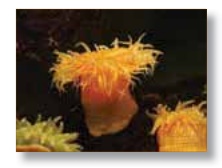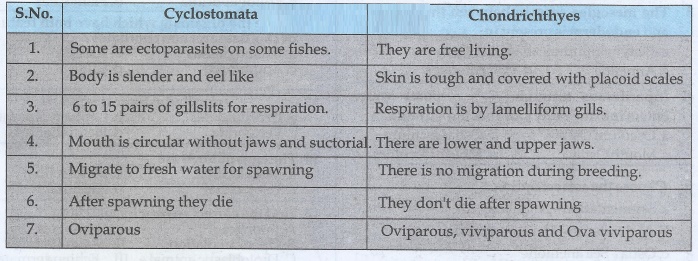Kingdom Animalia | Zoology - Answer the following questions | 11th Zoology : Chapter 2 : Kingdom Animalia
Chapter: 11th Zoology : Chapter 2 : Kingdom Animalia
Answer the following questions
Zoology
Kingdom Animalia
Answer the following questions
22. Why are spongin and spicules important to a sponge?
1)
Choanocytes or collar cells are special flagellated cells lining the spongocoel
and the canals.
2)
The body is supported by a skeleton made of spicules or spongin or both.
3)
The spicules are made up of calcium and silica.
23. What are the four characteristics common to most animals?
1)
Cellular structure
2)
The nature of coelom
3)
Notochord
4)
Segmentation or absence of segmentation
24. List the features that all vertebrates show at some point in their development.
1)
Embryonic germ layer a) Endoderm, b) Ectoderm - Two germinal layers.
2)
a) Ectoderm, b) Endoderm, c) Mesoderm - Three germinal layers.
3)
Organogenesis
i)
Ectoderm - Skin, Hair, Nerve, Tooth, Nail
ii)
Endoderm-Intestine lung, Liver
iii) Mesoderm - Muscle, Bones, Heart
25. Compare closed and opened circulatory system

Open
Circulation
i.
There is no blood vessels
2.
Blood remains filled in the tissue spaces.
3.
(Eg.) Arthropods, Mollusca, Echinodermata.
Closed
Circulation
i.
Presence of blood vessels.
ii.
Blood is circulated through blood vessels.
iii.
(Eg.) Earthworm, Cephalochordates, Chordates
26. Compare Schizocoelom with enterocoelom

Schizocoelomates
•
Body cavity is formed by spilitting of mesoderm.
•
(Eg.) Annelids, Arrthopods
Enterocoelomates
•
The body cavity is formed from the Mesodermal pouches or archenteron.
•
(Eg.) Echinodermata Chordates
27. Identify the structure that the archenteron becomes in a developing animal.
The
truecoelom called enterocoel formed from the archenteron.
28. Observe the animal below and answer the following questions

a. Identify the animal
b. What type of symmetry does this animal exhibit?
c. Is this animal Cephalized?
d. How many germ layers does this animal have?
e. How many openings does this animal’s digestive system have?
f. Does this animal have neurons?
a)
Sea anemone
b)
Bilateral symmetry
c)
It is not a cephalized animal
d)
Diploblastic animal
e)
One
f) Yes.
29. Choose the term that does not belong in the following group and explain why it does not belong?
Notochord, cephalisation, dorsal nerve cord and radial symmetry
Unrelated
characters: Radial Symmetry
1)
Notochord, Cephalization dorsal nerve chord, are characteristic features of chordate
animals.
Radial
Symmetry
This
is the feature of invertebrate organism.
30. Why flatworms are called acoelomates?
The
body cavity is formed from mesoderm but in flatworms there is no body cavity their
body is solid with a perivisceral cavity.
31. What are flame cells?
Specialized excretory cells present in flatworms called flame cell helps in Osmoregulation and excretion.
32. Concept Mapping - Use the following terms to create a concept map that shows the major characteristic features of the phylum nematoda:
Round worms, pseudocoelomates, digestive tract, cuticle, parasite, sexual dimorphism

33. In which phyla is the larva trochopore found?
Trochopore
larva is seen in the Phylum - Annelida.
34. Which of the chordate characteristics do tunicates retain as adults?
1)
Presence of notochord below the nerve cord and above the alimentary canal.
2)
Dorsal nerve cord lies above the notochord and below the dorsal body wall.
3)
Pharyngealgill slits at some stage of their life cycle.
35. List the characteristic features that distinguish cartilaginous fishes with living jawless fishes

Cyclostomata
•
Some are ectoparasites on some fishes.
•
Body is slender and eel like
•
6 to 15 pairs of gillslits for respiration.
•
Mouth is circular without jaws and suctorial .
•
Migrate to fresh water for spawning
•
After spawning they die
•
Oviparous
Chondrichthyes
•
They are free living.
•
Skin is tough and covered with placoid scales
•
Respiration is by lamelliform gills.
•
There are lower and upper jaws.
•
There is no migration during breeding.
•
They don't die after spawning
•
Oviparous, viviparous and Ova viviparous
36. List three features that characterise bony fishes.
1)
The body is spindle shaped skin is covered by ganoid cycloid or Ctenoid scales.
2)
They have four pairs of filamentous gills with operculam on either side.
3)
Air bladder helps in gaseous exchange and for maintaining buoyancy.
4)
Sexes are separate.
5)
They have lateral line sense organs. The kidney is mesonephric.
37. List the functions of air bladder in fishes.
1)
Air bladder may be connected to the gut or not.
2)
They help in gaseous exchange.
3)
In ray finned fishes they help in buoyancy.
38. Write the characteristics that contributes to the success of reptiles on land.
1)
The body of reptile is covered by dry and cornified skin with epidermal scales or
scutes.
2)
All are poikilotherms.
3)
Most reptiles lay cleidoic eggs.
4)
Excretion is by metanephric kidneys and are uricotelic.
5)
They are monoecious.
6)
Internal fertilization is taking place
39. List the unique features of bird’s endoskeleton.
1)
The endoskeleton is fully ossified.
2)
The long bones are hollow with air cavities. So that they can easily fly with lesser
weight.
40. Could the number of eggs or young ones produced by an oviparous and viviparous female be equal? Why?
•
Each female gamete from a female unites with a male gamete (spermatozoa) of a male
through internal or external fertilisation and formszygote that will become a individual.
•
The number of female gametes produced is united with that much number of male gametes
and produced that much number of individuals. Hence the egg or young ones produced
by oviparous or viviparous female are equal
Related Topics